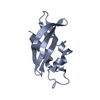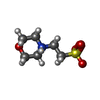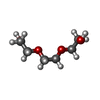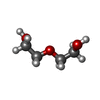+Search query
-Structure paper
| Title | Cryo-EM Structures Reveal Mechanism and Inhibition of DNA Targeting by a CRISPR-Cas Surveillance Complex. |
|---|---|
| Journal, issue, pages | Cell, Vol. 171, Issue 2, Page 414-426.e12, Year 2017 |
| Publish date | Oct 5, 2017 |
 Authors Authors | Tai Wei Guo / Alberto Bartesaghi / Hui Yang / Veronica Falconieri / Prashant Rao / Alan Merk / Edward T Eng / Ashleigh M Raczkowski / Tara Fox / Lesley A Earl / Dinshaw J Patel / Sriram Subramaniam /  |
| PubMed Abstract | Prokaryotic cells possess CRISPR-mediated adaptive immune systems that protect them from foreign genetic elements, such as invading viruses. A central element of this immune system is an RNA-guided ...Prokaryotic cells possess CRISPR-mediated adaptive immune systems that protect them from foreign genetic elements, such as invading viruses. A central element of this immune system is an RNA-guided surveillance complex capable of targeting non-self DNA or RNA for degradation in a sequence- and site-specific manner analogous to RNA interference. Although the complexes display considerable diversity in their composition and architecture, many basic mechanisms underlying target recognition and cleavage are highly conserved. Using cryoelectron microscopy (cryo-EM), we show that the binding of target double-stranded DNA (dsDNA) to a type I-F CRISPR system yersinia (Csy) surveillance complex leads to large quaternary and tertiary structural changes in the complex that are likely necessary in the pathway leading to target dsDNA degradation by a trans-acting helicase-nuclease. Comparison of the structure of the surveillance complex before and after dsDNA binding, or in complex with three virally encoded anti-CRISPR suppressors that inhibit dsDNA binding, reveals mechanistic details underlying target recognition and inhibition. |
 External links External links |  Cell / Cell /  PubMed:28985564 / PubMed:28985564 /  PubMed Central PubMed Central |
| Methods | EM (single particle) / X-ray diffraction |
| Resolution | 2.265 - 3.6 Å |
| Structure data | EMDB-7048, PDB-6b44: EMDB-7049, PDB-6b45: EMDB-7050, PDB-6b46: EMDB-7051, PDB-6b47: EMDB-7052, PDB-6b48:  PDB-6anv:  PDB-6anw: |
| Chemicals |  ChemComp-MES:  ChemComp-PGE:  ChemComp-EDO:  ChemComp-PEG:  ChemComp-HOH: |
| Source |
|
 Keywords Keywords |  IMMUNE SYSTEM / Type I-F CRISPR-Cas system: Csy Cascade: Structure: anti-CRISPR protein: Inhibition of Csy complex: Genome editing tool / IMMUNE SYSTEM / Type I-F CRISPR-Cas system: Csy Cascade: Structure: anti-CRISPR protein: Inhibition of Csy complex: Genome editing tool /  IMMUNE SYSTEM/RNA/DNA / IMMUNE SYSTEM/RNA/DNA /  CRISPR-Cas / CRISPR-Cas /  IMMUNE SYSTEM-RNA-DNA complex / IMMUNE SYSTEM-RNA-DNA complex /  IMMUNE SYSTEM / RNA / IMMUNE SYSTEM / RNA /  IMMUNE SYSTEM - RNA complex / IMMUNE SYSTEM - RNA complex /  IMMUNE SYSTEM/HYDROLASE/RNA / IMMUNE SYSTEM/HYDROLASE/RNA /  IMMUNE SYSTEM-HYDROLASE-RNA complex IMMUNE SYSTEM-HYDROLASE-RNA complex |
 Movie
Movie Controller
Controller Structure viewers
Structure viewers About Yorodumi Papers
About Yorodumi Papers














 pseudomonas phage jbd30 (virus)
pseudomonas phage jbd30 (virus)